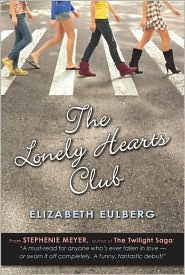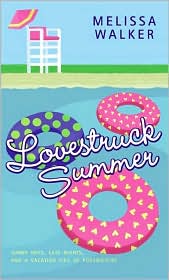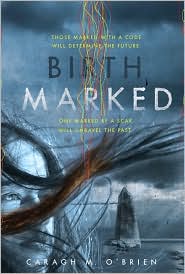For publishers--and please, correct me if I'm horrendously wrong, as I am simply going off intuition here--blog ratings most likely don't mean two craps: the most important part is getting word of the book out there, which publishers will do for their big-name titles, no matter how bad the book is or how negative the critical reception has been (see: Fallen. Heh. I couldn't resist it. Sorry. Moving on now). The thing that "matters" for authors and publishers seem to be the starred reviews from the big honchos of book reviewing: publications such as Publishers Weekly, School Library Journal, and Kirkus Reviews (long may ye reign!)--and even their importance is a little murky and shifting with today's customer-as-reviewer economy.
So in what context, then, should the ratings assigned to books by bloggers and found on book social networking sites be considered? And how can we best use the legend/threat/customer-is-always-right thing that is ratings to ensure the most pleasant reading and recommendation experience for the greatest number of people?
This topic will be broken up into two parts. In the first, this post, I break down how I use my 5-point rating system, what it means when you see a particular rating attached to a particular book, and how the rating is affected by factors such as genre and expectations. In the second, a post perhaps a week or so from now, I will talk about how I, as a reader of books and blogs, use the ratings I come across in different aspects of the blogosphere and the online book community.
I mention briefly in my review policy that I use a rating scale of 1 to 5, with half-"stars" (we'll call them stars here so we're on the same page) given. I break my rating down in 3 categories: writing (how well the author conveys his/her intention through the style he/she uses), characters (dimensionality, believability, interestingness), and plot (pacing, predictability, originality). Of course my ratings are subjective and moody just like myself, which is why they only truly add up to the overall rating I assign the book about 25% of the time. The remaining 75% accounting for my arithmetically challenged ratings can be explained by the "invisible", subjective factors--which I will attempt to describe below.
Here, then, is my breakdown of ratings, and why they might mean different things for books from different genres, etc. Think of it as one of those "holistic" rubrics that English teachers hand out before timed or standardized essays, bwahahaha. Okay, not. And NOTE! The following descriptions apply only to ratings that appear on this blog. Since Goodreads doesn't allow half-stars, I sometimes have to consolidate.
Now, since I like to end on a good note...
1 star. A book whose published status I sincerely and horrifically question. It reads like a brainstorming of a first draft of a writing exercise assigned by the most mediocre writing program desperate money can buy, a writing exercise that should probably be discarded and erased from one's consciousness the minute it's turned in for a (bad) grade. Unsurprisingly, a lot of self-published books would fall into this category for me. Without the helpful hand of critique partners, agents, or editors, these authors have invariably published a piece of drivel that they self-inflate to be the best thing since, like, The Da Vinci Code. I'm appalled to even post a review of this book up anywhere, let alone let the name of its title cross my lips. It truly, honestly, sincerely-with-all-my-heart deserves to be returned to the bottom of the "past writing projects" file cabinet, and revised only when the author has enough distance from it that he/she can see its multiple large flaws and completely overhaul the idea. I've only given one 1-star review on my blog ever, thankfully.
1.5 stars. The lowest rating that I've given to a book published by an established and respectable publishing house, figuring as at least two professionals in the publishing industry must have liked it to have published it. These books are--and it can't be put any other way--quite bad. Often it's a novel written by an author who's written about 20 books prior to it, and thus their publishing company has probably lost sight of the fact that this? their latest manuscript? Quite subpar compared to their very first book, the one that helped them break into the industry, y'know? Characters are flat, plots are either unoriginal or poorly executed (i.e. I'm not engaged). The story remains always a "story" and never escapes the borders that fiction has erected around it.
2 stars. Books that I give 2 stars to are, it seems, those that were probably marketed to the wrong audience, or bad books that were marketed precisely to the only audience that is able to indulge in them. So here you've got your paranormal romance MG/YA bestsellers whose mediocre writing and unoriginal characters/plot are covered up by the fact that it's *gasp* TRUE, ETERNAL, AND UNDYING LUV! and *swoon* VAMPIRES!--and those YA books written by authors who probably should've stuck with writing adult or children's fiction. These books just miss the mark for me: most of these have an established fan base, but are not the types of books that I'd read and enjoy on my own.
2.5 stars. 3 stars is pretty much the cutoff point for books that I would've picked up on my own and have finished; ratings less than 3 indicate that it's not a book I'd recommend. There's nothing too wrong about books I give 2.5 stars to; like 2-star books, they're usually just the wrong book for me. What distinguishes a 2.5 from a 2 is that the 2.5s are, in fact, pretty well written in their genre. There's an audience for these books; again, the audience just wasn't me.
3 stars. Here's where things get trickier. I've noticed that most of the books I give 3 stars to fall into 2 groups: books that are not my type (girly, semi-predictable, white suburban middle-class, happily-ever-after) but that I would still recommend for people who enjoy that type of books, and books that were raved about by fellow book-lovers and, sadly, fell way short of my expectations. The last 3-star book I reviewed that fell into the first group (let's call it Type A) was The Lonely Hearts Club by Elizabeth Eulberg--a perfectly pleasant and enjoyable teen romance novel that wasn't quite my cup of tea due to its predictability, saccharine romance, cardboard supporting characters, and cookie-cutter whiteness. I specifically named that example because I was still rather entertained by said book--call it a guilty pleasure, if you will. I won't give an example of a Type B 3-star book, as that is less flattering, but let's just say that Type B 3-star books tend to be books that have been long hyped about in the YA blogosphere and Twittersphere, and whose 5-star ratings on Goodreads typically consist of fangirly gushings of "OHMIGOD this is the best book I've ever read! Girl X and Boy Y are sooooo cute together!" and the like. As for some 2.5-star books, Type B books generally get a welcome reception into the world; it just wasn't really for me.

3.5 stars. Again, can mostly be divided up into Type A and Type B. A Type A novel (refresher: not the type of book that's usually on my radar, usually on account of excessive girliness, predictability, and commercialized appeal) that I would probably consider one of my favorites if, you know, I was the type of reader who loved those types of books. Type B books earn 3.5 stars if I can see the author's intentions and admire it but the intentions didn't quite manifest themselves completely in the book, or if it's a book I've been looking forward to that falls just a cut below my really liking it and wanting to recommend it to lots of people. I've also noticed that 3.5 tends to be the highest rating I give to middle-grade novels sent to me for review. Guess that means I'm a YA snob, eh? Ahh, I tried. Consider a 3.5 rating on a middle-grade novel very, very good, and pass it on to the middle schooler in your life.
4 stars. Okay, honestly? I know there are two more levels of ratings above this and all, but I just might love 4-star books the most, and this is hard for me to explain. There are several "categories" of 4-star books. There's the (usually) paranormal romance book with mass audience appeal that I still enjoyed despite the fact that it was most likely a done-before paranormal romance idea (at the most basic level: human girl with the irresistible supernatural male crush, magical element that threatens to keep the two lovers apart) with writing that reminds me of the first time I read Twilight: "Well, golly, this is easy to read. If she can get this published, so can I!" There's the good book written by the established YA author that will easily be up for awards, despite the fact that the story idea wasn't all that original and/or interesting and probably would not have been published had the manuscript been submitted by a first-time novelist. There's the aforementioned Type A novel that completely blows all my preconceptions away and makes me fall in giddy--though certainly not eternal and undying--love with it (e.g. Lovestruck Summer by Melissa Walker--great book!). There's the book with the so-so execution but brilliantly unique concept. There's the book that's funny in the way I love: smart, witty, and neither condescending nor forced. Essentially, humor I could never in my life accomplish (examples: Dream Life by Lauren Mechling; Food, Girls, and Other Things I Can't Have by Allen Zadoff).
And then there are The Books. Ohhh, The Books. How I love you. Most of the time I don't even know why I only give you 4 stars and not higher, because I usually cannot stop talking about you to other people and driving them crazy with my recommending it. These books are great: original concept, top-of-the-line writing, entertaining, enthralling, eye-opening. These I would love to read again for the first time; these I usually end up buying the finished copy of for my permanent book collection. And maybe that's where the distinction lies: I'd love to read these books again for the first time, because they made the experience of reading so incredible for me. Some of these I'd never even dare to learn from, as their level of writerly sophistication is so utterly different from whatever writerly sophistication I'd like to hope I can master one day. And sometimes these books have a great message that's slightly hampered by the author's writing style--a style that's good but not outstanding, not really something they can fix, and yet something that readers can, for the most part, ignore in favor of the story. Books in this special 4-star category include: Bleeding Violet by Dia Reeves, Soulless by Gail Carriger, The Agency: A Spy in the House by Y. S. Lee, The Demon's Lexicon by Sarah Rees Brennan, The Red Umbrella by Christina Diaz Gonzalez.
You can usually tell which type of 4-star book it is by the tone and content of my review.
4.5 stars. Really, really good books that seem to have very little unifying theme other than the fact that I believe they're all written in the style that best expresses what they're trying to express. Whereas with The Books in the 4-star range I'd love to read them again for the first time, 4.5-star books are most likely one-time reads for me, albeit incredible one-time reads. They were just so enjoyable and impressionable and completely in line with what I'd want to take from books as a writer that I feel satisfied with having read them once, and encouraging others to read them at least once too, as they are absolutely essential in that respect.
5 stars. There are also two types of 5-star books. There's the kind that so completely bowled me over by the strength of their writing that I completely excused any possible weaknesses the book might have (usually in characterization). And then there's the kind that I read and reread and still love to death every time I do so. This latter category is further broken down into two types: books that are exemplars of their more lighthearted (usually contemporary realism) genre (e.g. Fat Cat by Robin Brande, The Actor and the Housewife by Shannon Hale, Poison Study by Maria Snyder), and books that effectively combine readerly engagement with thought-provoking concepts (e.g. The Hunger Games by Suzanne Collins, the upcoming Birthmarked by Caragh O'Brien).
-
And there you have it! Did you learn something new? Dedicated readers of my blog, have you been able to see these trends and divisions in my reviews, and to take them into consideration when "using" my reviews? I look forward to next week's post about trends I've spotted in other bloggers I respect, when reviews do or don't influence me, and the deal with an excess of 5-star reviews... but in the meantime, I'd love to hear from you! If you want to write a similar post about your own rating styles, feel free to do so and link back to it here. If you have any comments or questions, mention them below, and I might be able to include them in next week's post.








No comments:
Post a Comment